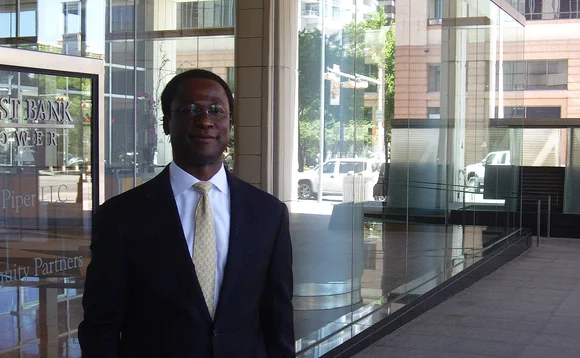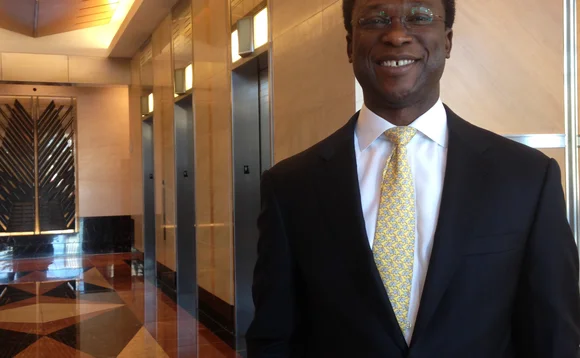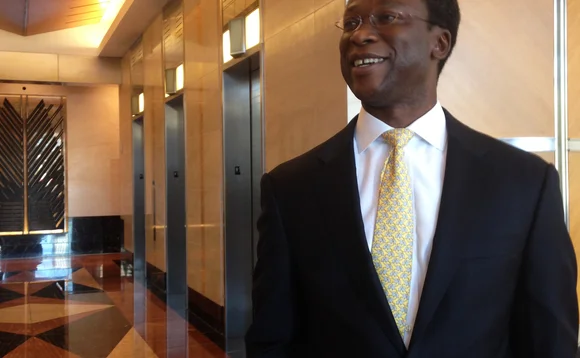Texas-Sized Technology: Utimco CTO Uche Abalogu






They say everything is bigger in Texas, starting with Texas itself. One could travel the equivalent distances from Amsterdam to Milan, or Paris to Vienna, or Boston to Washington, DC—and back again—and not leave the Lone Star State.
So much of the state’s identity rests on territoriality, on the land, and in no small part, on what lies beneath it. Yet unlike its Southwestern neighbors, very little of Texas is actually desert. And that, Uche Abalogu says, makes it great for something else: flying.
An amateur pilot and owner of his own Rockwell Commander 114, Abalogu is used to taking a view from elevation. His job as chief technologist demands it. So, too, is his employer as high up on the institutional investment chain as it gets—University of Texas’ massive, non-profit investment manager, known as Utimco.
Having worked at premier buy-side and sell-side shops before landing in Austin, Abalogu knows what to look for, and what to scrutinize, in a technology—whether it be for an in-house implementation, or doing diligence on one of Utimco’s many buy-side partners. The CTO insists he isn’t unique: Many endowments and pension funds across the country are beefing up their IT expertise as they diversify into new investment strategies. That may be so, but few among them have the perspective Abalogu does, especially from the cockpit, 15,000 feet up.
Taking Off
Like many Austinites, Abalogu traveled a long way to get here—even by Texas standards. Originally from Nigeria, he graduated with a degree in mechanical engineering from the University of Port Harcourt before moving to London to earn his master’s degree. Shortly afterward, he jumped across the pond to New York to join Goldman Sachs’ enterprise technology team and moved over to its Global Securities Services just as the bank was beginning to beef up its prime brokerage consulting services group in the mid-2000s. Targeting alternative managers, Abalogu worked with a variety of hedge funds, but was particularly interested in an engagement with Harbinger Capital, then a young fund growing into new long–short and event-driven strategies from its roots in distressed debt, that was seeking to completely refresh its trade processing across the shop, with a sizeable investment in IT. Abalogu was on point.
We suspected that what we were looking to build just would not exist at another endowment, so we wanted someone with broad experience, because today we essentially invest in everything, everywhere—we’re global in scope, and we invest in a broad array of asset classes and investment styles. - Bruce Zimmerman, Utimco CEO
“The first thing we did was review a full ‘day in the life’ of a trade, from the front-office systems, to prime brokers, administrators, and custodians, to catch where technology gaps were and trade breaks would happen,” Abalogu recalls. “Ultimately, a straight-through processing solution was implemented with the order management system, supported by a security master from Indus Valley Partners (IVP), which provided a way for their systems to generate a trade ‘shell’ for both the front office and the Geneva portfolio accounting system, reconciling both sides simultaneously, ensuring alignment throughout the course of the trade.”
Impressed with his efforts, Harbinger took the next logical step—prying him away—whereupon he further worked with IVP, adding the Polaris data warehouse for reporting, regulatory compliance filing data, and a trade reconciliation system. Abalogu’s arrival at Harbinger also coincided with the fund’s move to a new space on Manhattan’s Park Avenue, which provided the opportunity to redesign infrastructure, including new blades for trading workstations utilizing PC-over-IP technology from AmuletHotkey, and migration to virtual servers synchronized in real time with a remote disaster site.
“For me, the rationale for virtualization is system provisioning flexibility, dynamic system performance management, and high availability for business continuity, where resources can be managed up or down without major surgery or downtime, if architected properly. By the time I left Harbinger, we had doubled our servers from 21 to 42, while maintaining physical server count below 10,” he says.
Constitutional
That was in 2011, when—during a period when the fund became the subject of a US Securities and Exchange Commission (SEC) investigation—Abalogu sought a different kind of opportunity. In Austin, he found it. After all, few investment managers have their mandate actually written into a state constitution, the way Utimco does. The reasons are historical—and come back to land.
University of Texas, originally granted much of the land in present-day downtown Austin upon its founding, swapped property in a series of deals with the state around the turn of the 20th century that gave it 2.1 million acres in the Permian Basin in West Texas—much of which, it turns out, is absolutely flush with oil. Extracting the resource has become easier in recent years using new techniques, with the number of monthly barrels produced more than doubling since 2010.
That, along with oil’s buoyant price, has produced windfall licensing fees between $279 million in fiscal year 2009 and $648 million in 2013, a steady stream of income that now backs the largest public endowment in the US (and the world), by far. Utimco manages both the Permanent University Fund (PUF)—the sovereign wealth fund into which those monies proceed—as well as the General Endowment Fund (GEF) and operating funds, which combine to benefit both the University of Texas and Texas A&M University Systems. Among all endowment managers, Utimco’s $32.6 billion in assets are topped only by Harvard.
It is little wonder, then, that Abalogu was curious about the opportunity when he made the trip south in 2012. “Our CEO, Bruce Zimmerman, invited me down here. I remember how green and tranquil Austin was, how different it was. But I’d heard other endowment IT heads were in the running. Honestly, I didn’t think I had a chance,” he says.
For his part, Zimmerman explains that the Utimco board saw things very differently. “We suspected that what we were looking to build just would not exist at another endowment, so we wanted someone with broad experience, because today we essentially invest in everything, everywhere—we’re global in scope, and we invest in a broad array of asset classes and investment styles. Uche’s charge is to provide tools to assist our organization as it continues to develop and evolve,” Zimmerman says. “We were also fortunate that nothing was profoundly ‘broken.’”
Three Months of Learning
Abalogu points out that the trend is spreading, with many of the larger universities—Harvard, Vanderbilt, and Stanford, among others—bringing in CTOs from organizations like Caxton Associates, Advent, and Risk Consulting to recast the way endowments can make IT work for them. While many of Utimco’s challenges were similar in nature to Harbinger’s, though, Zimmerman wanted his new chief technologist to solve them in a very different way.
“The first thing Bruce told me was for three months, all you’re going to do is meet with every last person here, and understand what they need from IT,” he says. “It was a lot of listening, and that was a radical change from the past, where I felt I needed to propose projects, and produce results, right away.”
Such was the first step in an examination of Utimco’s technology across the board—and not only its systems, but processes, too. “What we’ve had to do on the analytics side, for example, is work with our vendors to get their tools to where we want them to be, understanding there’s no one cure-all for that process, with customization required to meet a given need. For instance, in that we don’t do active risk management, we’re not as worried about market risk and other things traditional investment managers are,” he says.
“We worry about tail risk, largely—what happens in extreme events, looking at concentration across geography, sectors, and other metrics—so the type of tools we use are all around scenario analysis,” Abalogu says, pointing out IFS State Street as one database provider Utimco uses, in addition to data from its custodian, BNY Mellon.
“The question is which vendor will get you 40 percent there, versus 55 percent there—who offers you the least amount of work to do? And our multi-asset class investment style is surprisingly complex: You have criteria when you start, but halfway through, an event might occur and you start viewing risk differently, or one of your external managers suddenly has a new idea, and you quickly have to accommodate that. Getting it perfect is almost impossible; however, I am blessed to have inherited great talents, with David Gahagan leading the infrastructure team, and Aman Jain heading our business analysis and UI design effort.”
Flying By Feel
With the exception of select fixed-income trading and money markets, and short-term cash management, Utimco largely outsources the management of its assets elsewhere—and in this sense, it operates very differently than the hedge funds or private equity giants it partners with downstream. Its internal data management requirements, however, are essentially the same—and growing.
So far, the CTO has overhauled the organization’s document management, is currently building an investment data aggregation system in collaboration with GlobeArc, and is 75 percent done with virtualizing its servers, which have grown to 54 from the 19 before his arrival, and prove particularly helpful in serving the various stakeholders throughout the UT System and individual universities—who all work on Utimco’s systems daily. A lot of good work remains, however.
“One of the shockers for me, moving from a hedge fund, is that there you’ll have your own reference data, at latest T+1, with all the missing referential pieces filled in, whereas here, our external managers might give us their top five and bottom five investments, or benchmark themselves to an index, or information on quarterly risk profile changes,” Abalogu explains.
“We have to extrapolate the data in the middle by proxy, filling in the gaps from our managers’ reports, along with Bloomberg and FactSet, depending on what kind of investment is in question,” he says. “We’re good enough at it now that we can predict managers’ performance month-to-month in certain asset classes, and that helps us talk to the manager if things don’t happen as we expect them. Whether it is 'strategy drift' or something extraordinary, we know what the norm should be. So we’re working on perfecting that across the asset classes, designing a neutral process to integrate real data with that proxy data and aggregating it into buckets, some—like net-asset value (NAV)—that are broadly applicable, and others that are specific to certain investments, like internal rate of return (IRR) or multiples of capital.”
The process is made trickier, too, because performance data coming in isn’t uniform. Another important role for Abalogu is to help advocate for Utimco—and investors like it—as the industry grapples with data standardization issues, particularly around esoteric private equity and real estate transactions, and other bespoke investments like natural resources and venture funding that now constitute a significant chunk of Utimco’s portfolio.
“Lindel Eakman, our head of private investment, has worked hard for many years with the Institutional Limited Partners Association (ILPA) on that, and we are now part of the AltExchange alliance to really continue the push forward,” he says. “Technology has a role to play, but it’s more down to will and organization among limited partners (LPs) to drive that change. What we’d like to see is all the competitors—iLevel, Investran, Burgiss, and eFront, among others—as well as the general partners (GPs), to find common ground in reporting investor cashflows, capital accounts, and deeper portfolio information one way. Right now, we’ll get some data from a GP on a portfolio company—maybe its equity or income—but we don’t know if its debt, cash investments, or movement in the company’s financial evolution underneath. Likewise, if we see private equity cashflows or fund information from any of our GP partners—whether KKR, Blackstone, OakTree Capital, or TPG—it should come in the same way. From where we stand, we don’t care what the means are; the end result is what we care about. We have north of 3,000 portfolio companies through our GPs across the book now. Modeling with data uncertainties is bad for everybody, but that’s the world where we live in. Change has to start from somewhere.”
Tech Diligence
The scrutiny doesn’t end there. One of Abalogu’s other tertiary responsibilities is to help with technology diligence on new start-up managers, with which Utimco proudly works quite frequently.
“What we typically find is that seasoned managers have the processes in place that we look for; they’re big and have solid operations, or have spun out from somewhere larger,” he says. “With start-ups, what we want to know is how they’re thinking about their growth: the size of the back office, growth in automation, bringing on multiple prime brokers and custodians at a certain point. We don’t impose a standard—there are many variations on ‘right’—but there’s integrity for us in that information. It’s about a clear evolution and clarity of thought and consideration with regard to systems and operations.”
As for Utimco itself, Abalogu says his role is to provide the organization with as much flexibility as possible—including the ability to go the way of a handful of its private peers, and start hiring active managers to do more trading in-house. “Most of all, we’re pragmatic, and that’s the value of being CTO here. As I’ve learned the space, and with my experience, our team can accommodate whichever way our board wants to go,” he says.
Sunny Seasons
In the meantime, Texas offers him four sunny seasons to play soccer—and get up in the air more often. Like Abalogu’s work at Utimco, flying in Texas still demands some subtle adjustments, but the new view—and opportunity to teach his 11-year-old daughter, who is interested in aviation—is well worth it.
“By the time weather fronts come through in the northeast, they’re usually pretty muted; here they’ll pop up very, very quickly,” he says. “But the Gulf Coast is less than an hour away, Dallas is only an hour, New Orleans isn’t much further, and in Texas you have Big Bend, South Padre Island, Galveston, Enchanted Rock—it’s really awesome terrain. From the ground, it might look quite featureless; from the air, it’s fascinating.”
Of course, the flat parts have their benefits, too. And speaking like a CTO responsible for public money, and building the technology used to track its deployment around the world, Abalogu saves the most important point—security—for last.
“In an emergency, other than taking down a few juniper trees,” he says, “you can land almost anywhere.”
Fundamental Data
- Name: Uche Abalogu
- Age: 44
- Title: CTO and managing director
- Assets Under Management: $32.6 billion
- Size of Staff: Utimco: 65; IT: 10
- Education: Bachelor’s degree in engineering from University of Port Harcourt in Nigeria, and a master’s degree in computer science from University of North London in the UK
- Hobbies: Amateur pilot and playing soccer
IT at Utimco
- Biggest technology challenge at Utimco: Building our investment data aggregation system and standardizing/automating a common exposure reporting template across all our asset classes: hedge funds, long-only, privates, real estate, and natural resources.
- Notable accomplishments to date: Since I’ve been here, we’ve gone live with our document management system (working with partners, GlobeArc). We’re in progress with our investment data aggregation system.
- Technologies under evaluation: Airwatch, Citrix mobile offline desktop, SharePlus, and IVP Karma.
- IT wish list: Seamless, secure bring-your-own-device (BYOD); secure “offline” Utimco “applications” delivery to user personal devices (iOS, Android, Windows, Mac OS); profile-based applications provisioning.
Only users who have a paid subscription or are part of a corporate subscription are able to print or copy content.
To access these options, along with all other subscription benefits, please contact info@waterstechnology.com or view our subscription options here: https://subscriptions.waterstechnology.com/subscribe
You are currently unable to print this content. Please contact info@waterstechnology.com to find out more.
You are currently unable to copy this content. Please contact info@waterstechnology.com to find out more.
Copyright Infopro Digital Limited. All rights reserved.
As outlined in our terms and conditions, https://www.infopro-digital.com/terms-and-conditions/subscriptions/ (point 2.4), printing is limited to a single copy.
If you would like to purchase additional rights please email info@waterstechnology.com
Copyright Infopro Digital Limited. All rights reserved.
You may share this content using our article tools. As outlined in our terms and conditions, https://www.infopro-digital.com/terms-and-conditions/subscriptions/ (clause 2.4), an Authorised User may only make one copy of the materials for their own personal use. You must also comply with the restrictions in clause 2.5.
If you would like to purchase additional rights please email info@waterstechnology.com
More on Emerging Technologies
Data standardization is the ‘trust accelerator’ for broader AI adoption
In this guest column, data product managers at Fitch Solutions explain AI’s impact on credit and investment risk management.
BNY inks AI deal with Google, Broadridge moves proxy voting to AWS, Expero delivers ICE market data, and more
The Waters Cooler: TSX Venture Exchange data hits the blockchain, SmartTrade acquires Kace, and garage doors link to cloud costs in this week’s news roundup.
Everyone wants to tokenize the assets. What about the data?
The IMD Wrap: With exchanges moving market data on-chain, Wei-Shen believes there’s a need to standardize licensing agreements.
Google, CME say they’ve proved cloud can support HFT—now what?
After demonstrating in September that ultra-low-latency trading can be facilitated in the cloud, the exchange and tech giant are hoping to see barriers to entry come down.
Waters Wavelength Ep. 342: LexisNexis Risk Solutions’ Sophie Lagouanelle
This week, Sophie Lagouanelle, chief product officer for financial crime compliance at LNRS, joins the podcast to discuss trends in the space moving into 2026.
Citadel Securities, BlackRock, Nasdaq mull tokenized equities’ impact on regulations
An SEC panel of broker-dealers, market-makers and crypto specialists debated the ramifications of a future with tokenized equities.
BlackRock and AccessFintech partner, LSEG collabs with OpenAI, Apex launches Pisces service, and more
The Waters Cooler: CJC launches MDC service, Centreon secures Sixth Street investment, UK bond CT update, and more in this week’s news roundup.
Tokenized assets draw interest, but regulation lags behind
Regulators around the globe are showing increased interest in tokenization, but concretely identifying and implementing guardrails and ground rules for tokenized products has remained slow.







